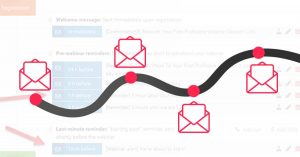
Heather here 🙂
So the manic month of December is almost over. Honestly, as much as I LOVE this time of year, I don’t think I’m the only person who’s ready to wave ‘Adios’ to 2020!
It’s been a mad rush of trying to tie up loose ends on the various campaigns we have going out. One thing I’ve been learning to do more of is streamline my processes. This has especially come in handy considering the fact that I currently manage five different inboxes. Each inbox has at least two campaigns running at any given time – meaning that emails take up a LOT of my working hours.
Thanks to some prodding from Deepak, I’ve finally gotten round to drafting canned responses for various campaigns and saving them to templates. I frankly don’t know why it’s taken me so long to do this – it’s been a game changer!
In my last post, I talked about writing effective copy for cold email. I’m going to continue that here by explaining the power of the follow-up sequence (as well as pitfalls to avoid…pitfalls I myself have fallen into on many an occasion)!
How to Write Follow Up Sequences

So the initial email has gone out. It might have been opened. It might not have. It might’ve been snoozed, or buried in the inbox, or perhaps even mistaken for spam and deleted.
How many times have you seen an email come into your inbox and thought ‘I’ll respond to that one later’? Then life gets in the way, more emails flood in, and before you know it, you’ve forgotten that it ever existed!
I used to think that if people didn’t reply to my initial email, it was clearly their way of politely saying ‘no thank you’. However, after seeing the replies I’d get from follow-up sequences, I realised that many times this simply wasn’t the case!
But how do you write a follow-up email that isn’t annoying? Well, first of all:
There’s always someone, somewhere, who will find your emails annoying.
That was an important lesson for me to learn after I received some less-than-friendly responses to my follow-ups. No matter what you say, or how you say it, there’s always going to be that one person who’s had a bad day (or year) and take umbrage with your audacity.
While it’s not always pleasant getting those kind of responses, the fact is that you NEED to be audacious when it comes to networking and marketing. If you don’t ask, you don’t get!
So now that we’ve established why follow-up sequences matter (and why you should do them anyway, even if you get a few crochety replies), I’ll wind this post up with an example of how I write follow-ups for Pearl Lemon.
Remember the interview example from my last post? Let’s revisit that thread here:
EMAIL 2:
Hi Liz!
Heather here from Pearl Lemon. Was just wondering you saw my last email about featuring you in our latest interview series :D?
We’ve already had some GREAT responses from other experts in your space. You can check out some of their contributions over at our blog:
{{insert link}}
Would still LOVE to get you on board with this. Any chance you’re up for it? 😀
EMAIL 3:
Hey Liz!
Heather again :). Just wanted to this bounce this thread back up to the top of your inbox in case it got buried!
Still really hoping I can convince you to be featured in our exclusive interview series for Pearl Lemon (with a backlink to your website, of course)! What do you think? Or is there a better time to reconnect about this?
You get the idea?
The tone of the emails is really, really important. I especially found I had more success with adding that sentence about ‘is there a better time to revisit this’. Often, the negative replies I was getting weren’t so much ‘I don’t want do this’ as ‘I can’t commit to this right now’. Offering an alternative time to touch base about the opportunity actually helped me turn quite a few ‘no thank you’s into ‘sure why not’s.
And as I point out in my last blog post:
The objective is to get the person to say ‘yes’!
